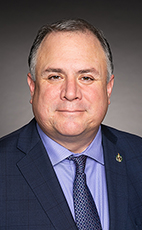44th Parl. 1st Sess.
October 17, 2023 10:00AM
- Oct/17/23 10:27:24 a.m.
- Watch
Mr. Speaker, the experiment that the NDP tried on the people of the Downtown Eastside, to decriminalize and provide taxpayer-funded opioids, to the great profit of the pharmaceutical companies that caused the crisis in the first place, caused misery and despair, a 300% increase in drug overdose deaths.
They then took that experiment, under the NDP Prime Minister, and, yes, he is an NDP prime minister, and they spread it right across the country. We now have 30,000 people who have lost their lives. The working class has been devastated under this NDP-Liberal coalition. There is only one party that stands up for the hard-working people and their wages in a drug-free, growing economy that gives people a chance to get off the street and into homes and better lives. That is the Conservative Party.
140 words
- Hear!
- Rabble!
- add
- star_border
- share
- Oct/17/23 6:25:11 p.m.
- Watch
Madam Speaker, I am here tonight on behalf of the 40,000 Canadian families that have lost loved ones since 2016, since the Liberals formed government, due to the toxic drug supply. I am here also on behalf of those living with problematic substance use and recreational substance use who are dying from preventable deaths.
Just to give some context, right now in Canada, about 180 Canadians per million die due to toxic drugs. In British Columbia, my home province, it is 430. In the Island Health region, it is over 500, and in the Alberni Valley, where I live, it is over 1,000. For those under the age of 49, it is right now over 2,100 people per million who are dying from toxic drugs. It is off the chart.
I have been asking, and New Democrats have been asking, for the federal government to come up with a plan, a timeline and resources to respond to this health emergency. In fact, not only has the Liberal government failed to do that, but it also has not spent even 1% of what it spent on the response to the COVID-19 pandemic. Why is that? It is because of the stigma. That is the only reason it has not responded. There are solutions out there.
I took it upon myself to go to Portugal last summer, on my own dime, to learn from Portugal, because it had six deaths per million. To paint the picture of how many people are dying in Canada, just to put things in perspective, more people have died in Canada from a toxic drug supply than in all of the European Union, with a population of over 450 million people.
The Portuguese story is quite interesting, because that country had a massive drug crisis that was claiming the lives of many people in the mid-nineties. Over 1,000 people were dying, primarily heroin users. There were 1,000 heroin users in a population of 10 million people. Just to put things in perspective, in my home province of British Columbia, we have 100,000 chronic substance users in a population of five million people. We have double what they had, in terms of per capita usage, of chronic substance users.
The Portuguese realized it was a health emergency and responded like it was a health emergency. They convened a table of experts. They decided to move forward with expert-based policy. They created treatment on demand and a safer supply of substances. They scaled up. They had 250 people on methadone at the start of their program, and they scaled that up to 35,000 in two years. They used the military to create labs, to lower the cost and to get supply out the door. Today, they have 20,000 chronic substance users. They focused on harm reduction, making sure that people got the support they did.
I will talk about the politicians and what they did. They were the heroes. They took the gloves off, stepped out of the way, stopped playing politics and got rid of their ideology. Portugal focused on evidence-based decision-making led by experts, and put forward a plan with resources, a timeline and a strategy. It was unbelievable.
We actually had an expert task force on substance use from Health Canada. What did the federal government do? It chose to ignore them. There is still no plan, no timeline and no resources. When is the government going to treat this as a true public health emergency? Where is the urgency?
597 words
- Hear!
- Rabble!
- add
- star_border
- share
- Oct/17/23 6:29:08 p.m.
- Watch
Madam Speaker, I want to thank the member for his passion on this topic. I have spoken to him several times already since I started in this role, and I can only learn from this member and continue to appreciate his passion and knowledge on this topic.
This toxic drug and overdose crisis is having a tragic and unrelenting toll on Canadians, their families and communities, and the member knows this. There are four pillars recognized internationally that are necessary for a successful substance use strategy: prevention, harm reduction, treatment and enforcement. We are committed to a comprehensive approach that implements policies and supports in all four of these essential areas. The member opposite is a key ally in solving this crisis.
Every person who overdoses is somebody who has a family and somebody who has people who care about them. I believe these deaths are, as the member said, preventable. Many of these individuals have perhaps hidden their drug use and feel unable or afraid to seek help. Many died alone. We must take urgent action to save lives and protect the health and safety of Canadians.
We have committed more than $1 billion for a full range of evidence-based actions focused on prevention, harm reduction, treatment and enforcement. Sadly, this crisis is evolving and worsening. The drugs are getting more toxic. Substance use intersects with other issues like poverty, homelessness and mental health. We need to evolve our understanding of the crisis and continue to improve the government's work to save lives, and protect the health and safety of Canadians.
Substance use is a health issue and health care is a shared responsibility across all levels of government. Most importantly, because I know some members in this House still disagree with this, harm reduction is health care. This is why we continue to support provinces, territories and indigenous communities to improve access to integrated, evidence-based substance use services and supports for all Canadians when and where they need it.
Creating false narratives is not useful to anyone. I am happy that the member for Courtenay—Alberni agrees with us on this and is helping us fight misinformation. We are providing nearly $200 billion to the provinces and territories over the next 10 years to support health system reform across Canada, and $25 billion of that money is for shared health priorities such as improving access to mental health and substance use services.
These historic investments will seek to integrate mental health and substance use care across the entire health system. This means that no matter where, when or how someone reaches out for help, there will be no wrong door, and I am optimistic we can get there. There is no one-size-fits-all solution to address this complex crisis. Each person's circumstance is unique. Solutions to the crisis must recognize that people use substances for different reasons and in different ways.
Offering treatment alone is not enough. Providing a broad array of care options and wraparound supports allows people to access the right services at the right time to improve their overall health and well-being.
We cannot end this crisis alone. It is our collective responsibility to work together as parliamentarians, with the member for Courtenay—Alberni, local communities, provinces and territories, as well as indigenous communities. We cannot be working in silos or through an approach that is not integrated.
572 words
- Hear!
- Rabble!
- add
- star_border
- share
- menumenu
- notificationsnotifications
- home
- mailmail
- searchsearch





